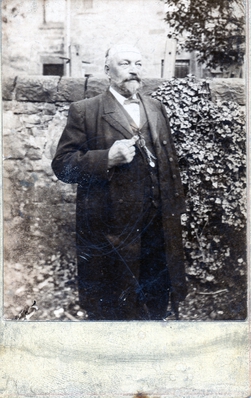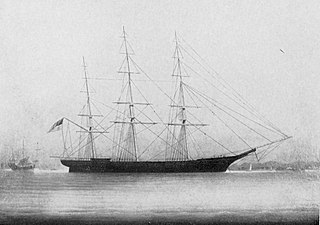
Sir Thomas Blaikie of Kingseat was a Scottish businessman who twice served as Lord Provost of Aberdeen, from 1839 to 1847 and 1853 to 1856.

When launched in 1853, Great Republic was the largest wooden ship in the world. She shared this title with another American-built ship, the steamship Adriatic. She was also the largest full-rigged ship ever built in the United States. She was built by Donald McKay for trade on his own account to Australia.

RMS Atrato was a UK iron-hulled steamship. She was built in 1853 for the Royal Mail Steam Packet Company as a side-wheel paddle steamer, and at the time of her launch was the world's largest passenger ship. In 1870 RMSP traded Atrato in, causing her to lose the status of "Royal Mail Ship". She was converted to a single screw ship with a compound steam engine in 1872, and placed on the Aberdeen Line that chartered her to run to Victoria and New Zealand. In 1880 she was renamed Rochester before sinking four years later in 1884 by running aground.

HMS Prince was a Royal Navy storeship purchased in 1854 from mercantile owners and lost in a storm off Balaklava in November that year during the Crimean War.
Fatima was an English barque that was wrecked on 26 June 1854 in the Torres Strait. She was built by R. Hutchinson, Sunderland, Tyne and Wear, launched in 1849 and registered at Liverpool. Her cargo capacity was 521 tons burthen.

Robert Nisbet (1834–1917) was a Shetland sea captain. He was born on 15 October 1834 at Burravoe on the island of Yell, Shetland. He died on 3 May 1917 at Leith, Scotland.
Gilmore, was a merchant ship built at Sulkea, opposite Calcutta, British India, in 1824. In 1829-30 she made a voyage delivering settlers to the Swan River Colony in Western Australia. She then made two voyages transporting convicts from England to Tasmania. She was wrecked in 1866.

Governor Ready was built at Prince Edward Island, Canada in 1825. She made two voyages transporting convicts from England and Ireland to Australia. She was wrecked in the Torres Strait in May 1829.
HMS Medina was a 2-gun Merlin-class paddle packet boat built for the Royal Navy during the 1830s. The ship remained in ordinary until she was commissioned in 1848. She was converted into a survey ship in 1856 and was broken up in March 1864.

The Murray was a three-masted clipper ship that was built in Scotland in 1861 and lost off the coast of Sweden in 1884. For nearly 20 years, the Orient Line sailed between London and South Australia. In 1880, Norwegian owners bought her and renamed her Freia.

South Australian was a composite-hulled clipper ship that was built in Sunderland in 1868 and sank in the Bristol Channel in 1889. She was a successor to clippers St Vincent and City of Adelaide. For nearly two decades she voyaged annually between London and South Australia.

The New Zealand Company was a 19th-century English company that played a key role in the colonisation of New Zealand. The company was formed to carry out the principles of systematic colonisation devised by Edward Gibbon Wakefield, who envisaged the creation of a new-model English society in the southern hemisphere. Under Wakefield's model, the colony would attract capitalists who would then have a ready supply of labour—migrant labourers who could not initially afford to be property owners, but who would have the expectation of one day buying land with their savings.

Lord William Bentink was launched in 1828 at Bristol. She made one voyage for the British East India Company (EIC), and one transporting convicts to Tasmania. She was wrecked on 18 June 1840 off the harbour of Bombay.
John Ralph Hansford Ward, invariably known as Hansford Ward or Captain Ward, was a ship's captain in South Australia, who figures prominently in the pre-history of the Adelaide Steamship Company. A son, also named John Ralph Hansford Ward but known as John R. H. Ward, was also a ship's captain.
Emma was a merchant vessel launched at Calcutta in 1809 that in 1810 served as a government armed ship in the British invasion of Île de France. In 1811 she sailed to England where she was sold. She then became a transport and later a whaler. Between 1815 and 1853 she made 11 whaling voyages. She was then sold and became a merchantman on the England-Australia run. Between 1851 and 1853 she made one more whaling voyage to the South Seas fisheries. She then returned to the England-Australia trade. In 1857 her home port became Hull, and she became a Greenland whaler, though that role may have begun as early as 1855. She was converted in 1864 to a screw steamer but was lost in April while seal hunting.

The SS Schomberg was a clipper built in Aberdeen by Alexander Hall & Co. for "the Black Ball line" for carrying large cargoes and steerage passengers, and to "outdo the Americans". When built, she was regarded as the most luxurious and well-built clipper of the period.

Monterey was a cargo schooner-rigged steamer built in 1897 by the Palmer's Ship Building & Iron Co of Jarrow for Elder, Dempster & Co. of Liverpool to serve on their cross-Atlantic routes.

Gravina was an 818-register ton clipper ship built in Hoboken, New Jersey, in 1853. A rare example of a clipper built in the United States for foreign owners, Gravina was originally homeported in Spain, though commanded by an American.













